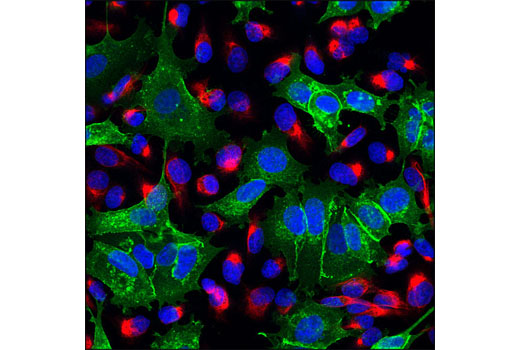| Products Included | No. | Volume | Applicaton | Dilution | Reactivity | Homology† |
|---|---|---|---|---|---|---|
| PathScan® EMT Duplex IF Kit Primary Antibody Cocktail | 7783 | 100 µl | Immunofluorescence (Immunocytochemistry), Immunofluorescence (Paraffin) | 1:100 | Human | Mouse |
| PathScan® Duplex IF Kit Detection Cocktail I | 7832 | 100 µl | Immunofluorescence (Immunocytochemistry), Immunofluorescence (Paraffin) | 1:100 | N/A | N/A |
†Species predicted to react based on 100% sequence homology.
| Kit Analytes | Detection Dye | Ex(max) (nm) | Em(max) (nm) |
|---|---|---|---|
| E-cadherin | Alexa Fluor® 488 | 495 | 519 |
| Vimentin | Alexa Fluor® 555 | 555 | 565 |
IF-P, IF-IC
#P08670, #P12830
7431, 999
Product Information
Storage
Specificity / Sensitivity
Species Reactivity:
Human
Source / Purification
Monoclonal antibodies were produced by immunizing animals with a synthetic peptide corresponding to residues surrounding Arg45 of human vimentin protein or residues surrounding Pro780 of human E-cadherin protein.
Product Description
Background
Epithelial-mesenchymal transition (EMT) refers to a biological process in which cells undergo a series of biochemical changes that induce a morphological transformation from an epithelial, polarized, adhesive state to an irregular, elongated, mesenchymal phenotype that enables migratory capacity (1,2). EMTs are classified into three subtypes: those involved in implantation, embryogenesis, and organ development; those associated with inflammation and fibrosis; and those involved in invasion and metastasis (1). Molecular changes that are associated with cells during this transformation include the loss of E-cadherin and gain of vimentin expression, hallmark epithelial and mesenchymal markers, respectively (3-5). Numerous studies have established that EMT is an essential step in cancer metastasis (5-7). E-cadherin is regarded as an active suppressor of invasion and tumorigenesis (8). In response to extracellular stimuli, vimentin coordinates various signaling pathways to induce spatial reorganization and structural changes (9), reminiscent of the EMT phenotype observed in motile cells involved in invasion and metastasis (6).
- Kalluri, R. and Weinberg, R.A. (2009) J Clin Invest 119, 1420-8.
- Lee, J.M. et al. (2006) J Cell Biol 172, 973-81.
- Yan, W. et al. (2010) J Biol Chem 285, 14042-51.
- Sethi, S. et al. (2011) Transl Oncol 4, 222-6.
- Kim, J.H. et al. (2007) J Korean Med Sci 22, 898-904.
- Emadi Baygi, M. et al. (2010) Cell Biol Toxicol 26, 553-67.
- Sethi, S. et al. (2010) Am J Transl Res 3, 90-9.
- Wheelock, M.J. and Johnson, K.R. (2003) Annu Rev Cell Dev Biol 19, 207-35.
- Helfand, B.T. et al. (2004) J Cell Sci 117, 133-41.
Species Reactivity
Species reactivity is determined by testing in at least one approved application (e.g., western blot).
Applications Key
IF-P: Immunofluorescence (Paraffin) IF-IC: Immunofluorescence (Immunocytochemistry)
Cross-Reactivity Key
H: human M: mouse R: rat Hm: hamster Mk: monkey Vir: virus Mi: mink C: chicken Dm: D. melanogaster X: Xenopus Z: zebrafish B: bovine Dg: dog Pg: pig Sc: S. cerevisiae Ce: C. elegans Hr: horse GP: Guinea Pig Rab: rabbit All: all species expected
Trademarks and Patents
使用に関する制限
法的な権限を与えられたCSTの担当者が署名した書面によって別途明示的に合意された場合を除き、 CST、その関連会社または代理店が提供する製品には以下の条件が適用されます。お客様が定める条件でここに定められた条件に含まれるものを超えるもの、 または、ここに定められた条件と異なるものは、法的な権限を与えられたCSTの担当者が別途書面にて受諾した場合を除き、拒絶され、 いかなる効力も効果も有しません。
研究専用 (For Research Use Only) またはこれに類似する表示がされた製品は、 いかなる目的についても FDA または外国もしくは国内のその他の規制機関により承認、認可または許可を受けていません。 お客様は製品を診断もしくは治療目的で使用してはならず、また、製品に表示された内容に違反する方法で使用してはなりません。 CST が販売または使用許諾する製品は、エンドユーザーであるお客様に対し、使途を研究および開発のみに限定して提供されるものです。 診断、予防もしくは治療目的で製品を使用することまたは製品を再販売 (単独であるか他の製品等の一部であるかを問いません) もしくはその他の商業的利用の目的で購入することについては、CST から別途許諾を得る必要があります。 お客様は以下の事項を遵守しなければなりません。(a) CST の製品 (単独であるか他の資材と一緒であるかを問いません) を販売、使用許諾、貸与、寄付もしくはその他の態様で第三者に譲渡したり使用させたりしてはなりません。また、商用の製品を製造するために CST の製品を使用してはなりません。(b) 複製、改変、リバースエンジニアリング、逆コンパイル、 分解または他の方法により製品の構造または技術を解明しようとしてはなりません。また、 CST の製品またはサービスと競合する製品またはサービスを開発する目的で CST の製品を使用してはなりません。(c) CST の製品の商標、商号、ロゴ、特許または著作権に関する通知または表示を除去したり改変したりしてはなりません。(d) CST の製品をCST 製品販売条件(CST’s Product Terms of Sale) および該当する書面のみに従って使用しなければなりません。(e) CST の製品に関連してお客様が使用する第三者の製品またはサービスに関する使用許諾条件、 サービス提供条件またはこれに類する合意事項を遵守しなければなりません。

